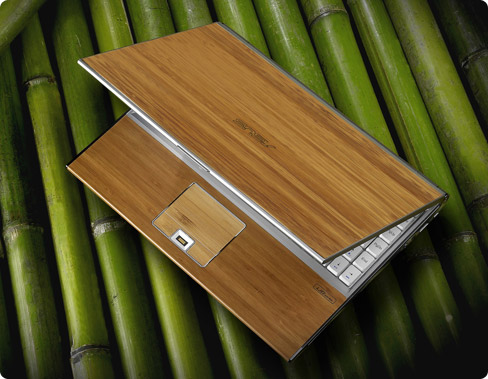Is a Bamboo Computer the Future of Electronics?
Is a bamboo computer a sign of the future of electronics and personal devices, or just the fancy of extremist environmentalists? Could it even be an April Fool's joke? Some computer makers are starting to think that natural products really can compliment the technological wizardry of our times.
In June 2007, Asus announced to the world that it was releasing a bamboo computer. True to their word, the ASUS Bamboo Series notebook was released in 2008.

The Asus Bamboo Notebook Computer
Not to be outdone, popular PC manufacturers Dell announced that they would be producing a bamboo computer casing, and a company called Micro Innovations intends to release bamboo encased accessories in April 2009 including a keyboard, mouse and webcam. The idea starts from a very serious reflection and an alarming ecological report: the components contained in our electronic computers and other machines are often highly toxic. And the electronic waste, like in big asbestos boats, is sent to developing countries to be reprocessed, dismantled and to be possibly recycled (in the best of cases). Without any protection, poor populations manipulate these chemical time bombs, poison themselves and release in the air and in soil the toxic products used in the high-tech products. Once again, the developed countries defer on the poor countries the pollution which they generate, rather than to manage it at home.
Greenpeace has rung the alarm bell bell of alarm at the right time on this subject, with its "Green my apple" campaign. It has borne fruit recently (the play on words was easy ;), Steve Jobs having promised “A greener Apple” in a text published some months ago. A good initiative therefore for Asus. The main environmental advantages and princples are to create a lasting, recyclable and energy efficient computer (and with a non-wasteful design).
- Lasting, with such a simple machine to disassemble that it is technically possible to easily replace faulty components, possible to upgrade when it is necessary. The goal: to increase the lifespan of the product and avoid unnecessary waste.
- Recyclable, with natural components, bamboo for the external panelage, cardboard for the assembly joints, recyclable plastic parts, numbered to make recovery and replacement easier, no paint or chemical coating in the design to avoid to the maximum the most toxic substances.
- Energy efficient, with a system of LEDs directly in the hull to avoid optical plastic materials (this point remains a bit obscure) and a green or red indicator to display the power consumption of the computer.
Also on this subject, Greenpeace published a very instructive Guide for a high-tech responsibility, where they state that in the area of mobile telephony it is Nokia which comes out first with an increasingly responsible environmental behaviour (no PVC in its new telephones, and movement toward abolition of all brominated flame retardants, many of which are highly toxic to small water living organisms). Concerning computers, it is Dell who leads the running to save the planet (for the same reasons and for its commitment in recycling in developed countries). To help in similar respects you can do the following:
- Don't throw away your computer when one of its components breaks down, but replace the individual component.
- If the situation is really too desperate, entrust its recycling to a specialised firm who will complete this work in protected conditions and properly reprocess the dangerous components.
External links:Ecopolit.eu cc 2.0
Please link to this page.
- Environmentally Friendly Innovations:
- Login to post comments
